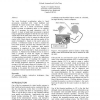Free Online Productivity Tools
i2Speak
i2Symbol
i2OCR
iTex2Img
iWeb2Print
iWeb2Shot
i2Type
iPdf2Split
iPdf2Merge
i2Bopomofo
i2Arabic
i2Style
i2Image
i2PDF
iLatex2Rtf
Sci2ools
CHI
2000
ACM
2000
ACM
Eye-hand co-ordination with force feedback
The term Eye-hand co-ordination refers to hand movements controlled with visual feedback and reinforced by hand contact with objects. A correct perspective view of a virtual environment enables normal eye-hand co-ordination skills to be applied. But is it necessary for rapid interaction with 3D objects? A study of rapid hand movements is reported using an apparatus designed so that the user can touch a virtual object in the same place where he or she sees it. A Fitts tapping task is used to assess the effect of both contact with virtual objects and real-time update of the center of perspective based on the user's actual eye position. A Polhemus tracker is used to measure the user's head position and from this estimate their eye position. In half of the conditions, head tracked perspective is employed so that visual feedback is accurate while in the other half a fixed eye-position is assumed. A Phantom force feedback device is used to make it possible to touch the targets in ...
| Added | 01 Aug 2010 |
| Updated | 01 Aug 2010 |
| Type | Conference |
| Year | 2000 |
| Where | CHI |
| Authors | Roland Arsenault, Colin Ware |
Comments (0)

